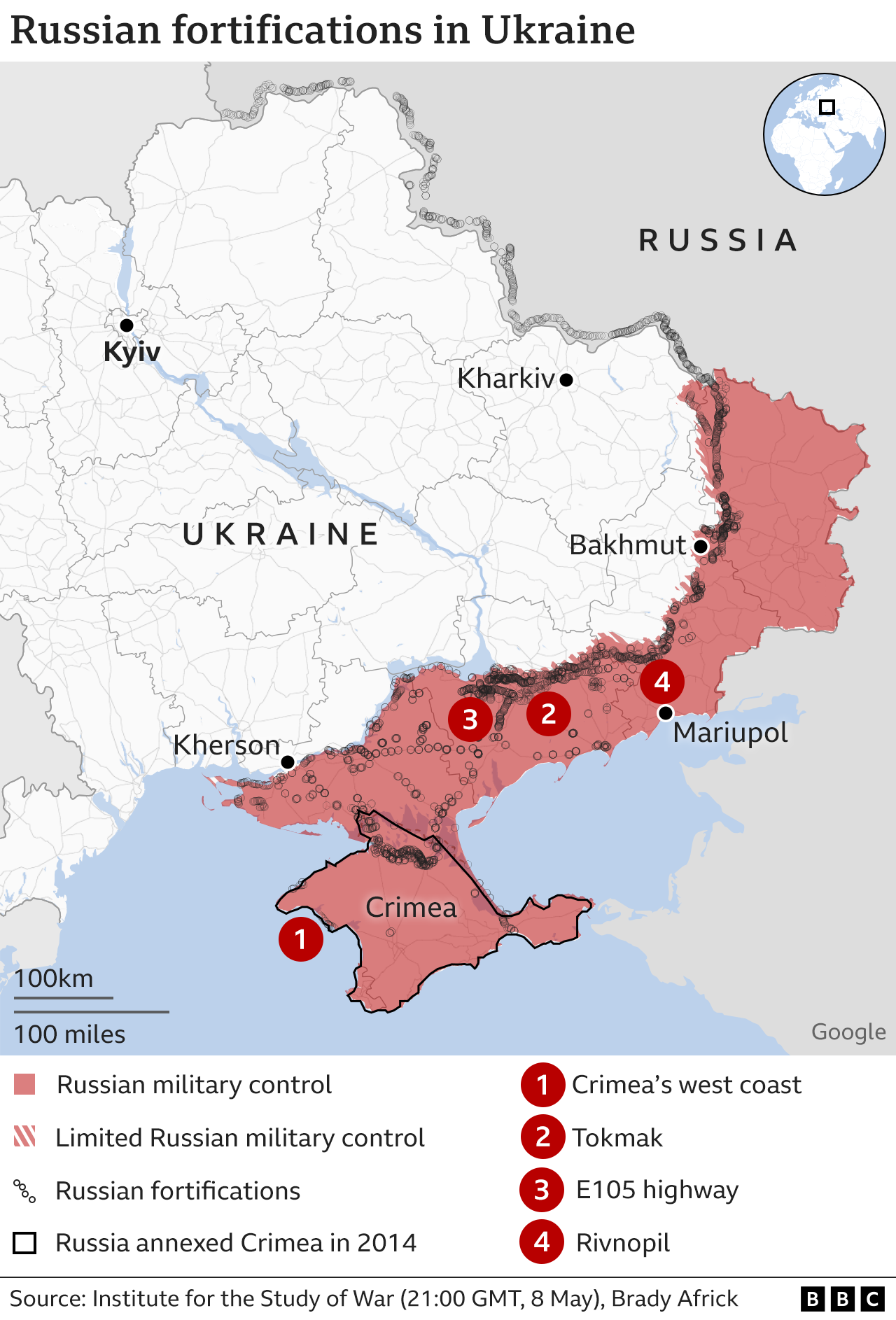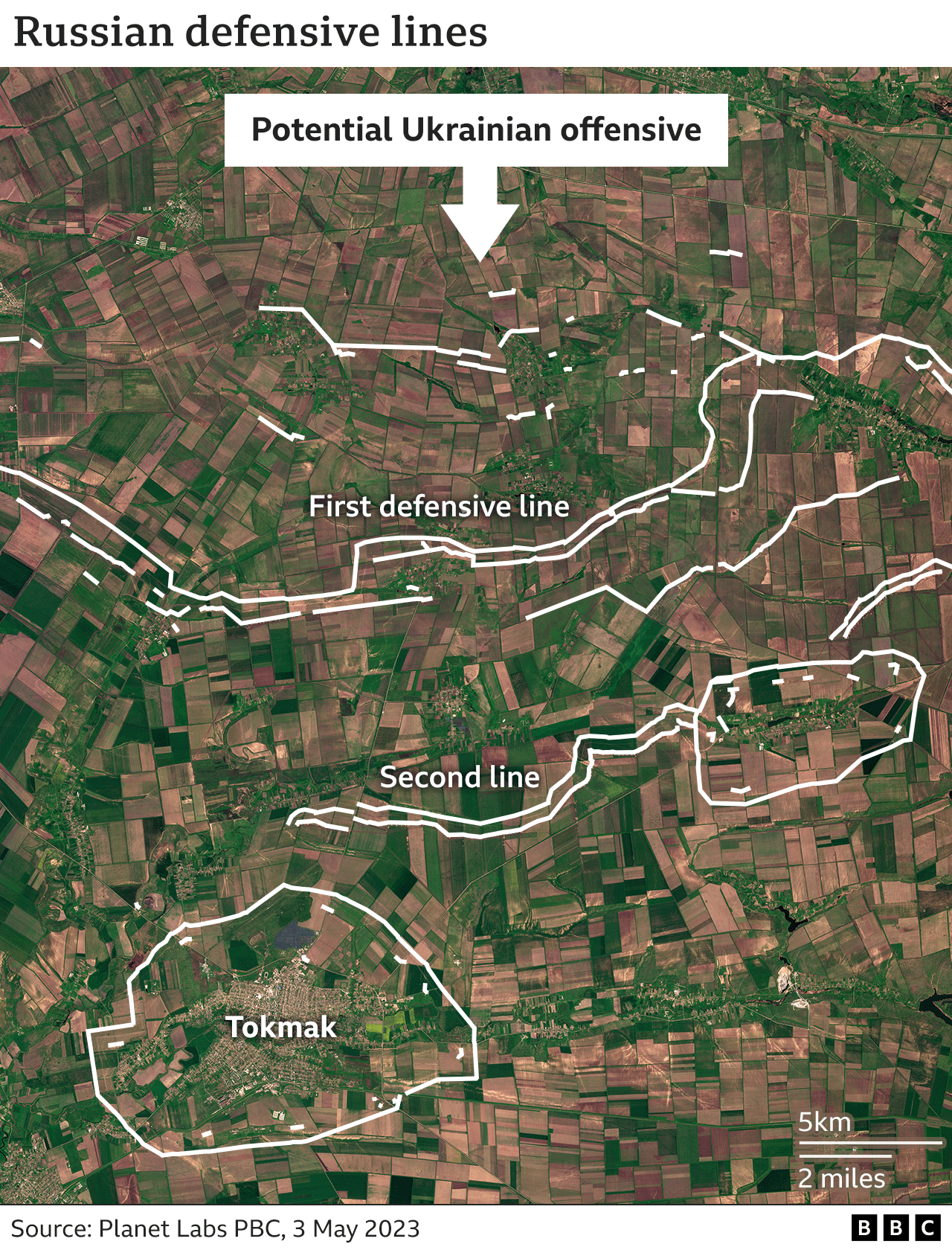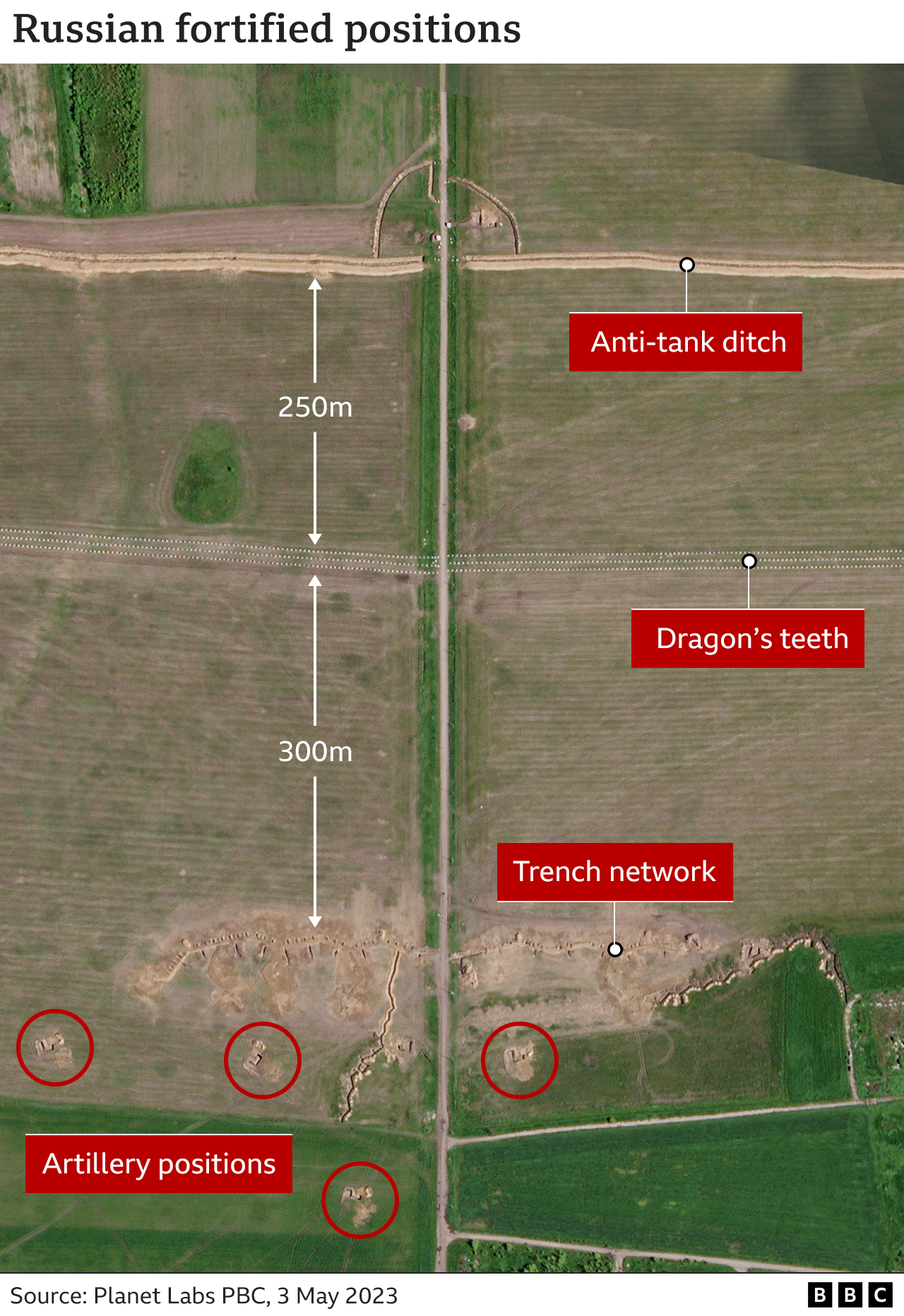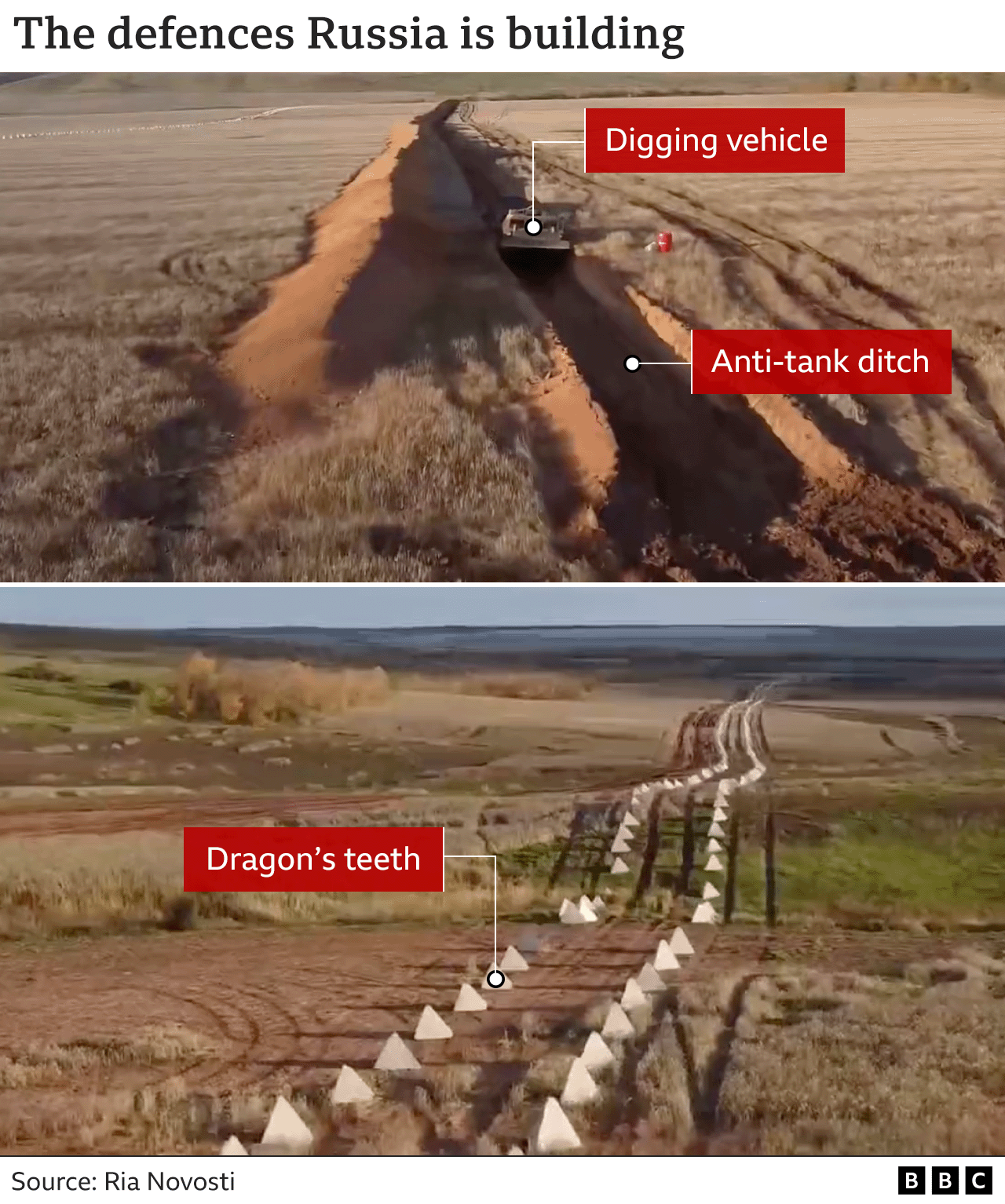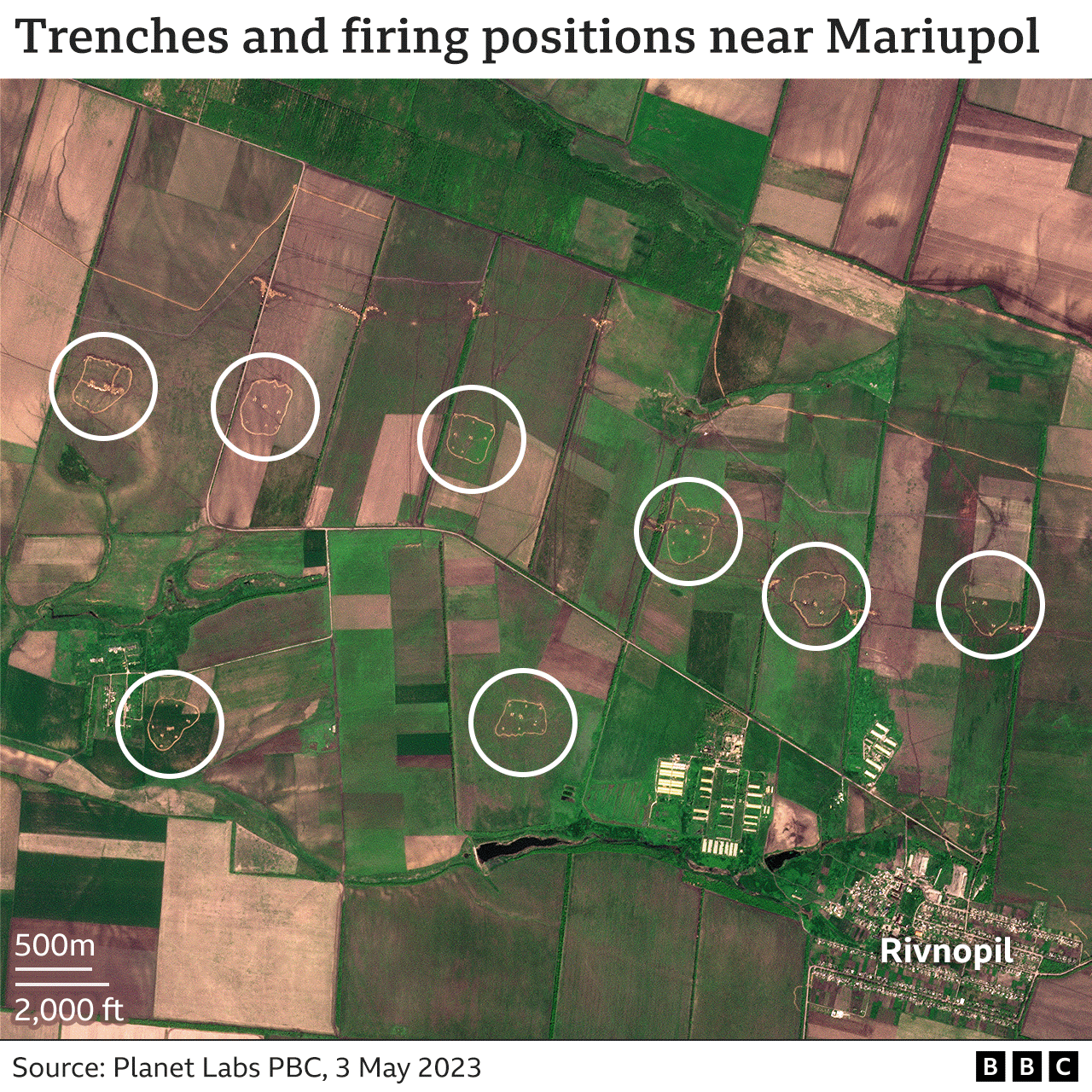BBC News 22 May 2023
A beach resort bristling with fortifications. A major road lined with anti-tank ditches. Satellite analysis by BBC Verify has uncovered some of the extensive defences built by Russia as it prepares for a major Ukrainian counter-attack.
After months of stalemate, the expected assault is likely to be a crucial test for Ukraine as it seeks to prove it can achieve significant battlefield gains with the weapons it has received from the West.
By examining hundreds of satellite images, the BBC has identified some key points in the significant build-up of trenches and other fortifications in southern Ukraine since October.
1. Crimea's west coast
Seized by Russia in 2014, Crimea was formerly known for its beach resorts.
Now, instead of sun loungers and parasols, the coastline stretching for 15 miles (25km) is littered with defence structures installed by Russian troops.
The image below shows the only open sandy beach on the west coast without natural defences such as cliffs or hills.
Firstly, there are "dragon's teeth" along the shore: pyramid-shaped blocks of concrete, designed to block the path of tanks and other military vehicles.
Behind them is a line of trenches, providing cover from incoming attacks. Several bunkers can also be spotted along the trenches.
Stacks of wood, digging machines and stores of dragon's teeth along the coast suggest building work was still in progress when the image was taken in March.
Some military experts suggest the defences are likely to be a precaution, rather than a sign that Russia expects to defend a seaborne assault, since Ukraine has little naval capacity.
Intelligence analyst Layla Guest says: "The fortifications are likely in place to deter any bold Ukrainian operation to attack Crimea via the sea rather than on land."
The beach fortification is just one example of a vast network of trenches, as shown by the black dots in the map below, based on work by open-source analyst Brady Africk.
BBC Verify has been able to identify other key fortification sites by pinpointing individual trench locations from videos on social media.
Once an exact location was discovered it was then possible to trace an entire trench network using satellite images.
2. Tokmak
The small city of Tokmak lies on a key route in the south-east of the country that Ukrainian forces may want to use to cut off Crimea from other Russian-held territories.
There have been reports that Ukrainian civilians have been moved out in order to turn the city into a military fortress. This would provide soldiers with access to supplies and a base to retreat to.
The satellite image above shows that a network of trenches in two lines has been dug north of Tokmak - the direction Ukraine would have to attack from.
Behind these trenches is a further ring of fortifications around the city, with three layers of defences that can be seen distinctly in this close-up satellite image.
The top of the satellite image shows an anti-tank ditch. These are usually at least 2.5m deep and designed to trap any enemy tanks that attempt to cross.
Behind the ditch are several rows of dragon's teeth and another trench network.
But Ukrainian forces are likely to face further traps.
It's highly likely that mines have also been hidden between Tokmak's three defence lines, says Mark Cancian from the Center for Strategic and International Studies.
"Minefields are a standard part of every defence, and the Russians have used them extensively throughout the war.
"Here they will be large and better concealed, slowing down Ukrainian attacks so that other combat elements, like artillery and infantry, can strike the attacking forces."
BBC Verify has also discovered three other towns near Tokmak have been similarly fortified.
3. E105 highway
A line of anti-tank ditches and trenches now runs alongside a 22-mile (35km) stretch of the E105 main highway, west of Tokmak.
The E105 is strategically important, connecting Russian-held Melitopol in the south with the northern city of Kharkiv, held by Ukraine. The side that controls it can easily move around troops around the region.
If Ukrainian forces attempt to use this road, Russia will likely target it with heavy artillery from behind their defences. Russia's position is also in range of another nearby road - the T401 - which could also be targeted.
"The Russians are worried about the recently built Ukrainian armour units. If these units can get on a main highway, they can move very quickly," says Mr Cancian.
"The Russian defences aim to push them off the roads and therefore slow them down."
4. Rivnopil, north of Mariupol
The port of Mariupol has a strategic position between the Russian-occupied territories in the east and Crimea in the south. It also became a symbol of resistance to invasion when a hard-core of fighters held out for months as the city was besieged.
Given Russia expects Ukraine to try to retake it, BBC Verify decided to look at the territory surrounding the city - leading to the discovery of a collection of circular trenches.
Located near the small village of Rivnopil about 34 miles (55km) north of Mariupol, each circular trench has a mound of soil in the middle, possibly either to protect artillery or to keep guns stable.
Meanwhile, the circular trenches allow soldiers to take cover and to move the artillery so it can aim in any direction.
It shows that Russia is preparing to defend areas of open ground (without natural protection from hills and rivers) alongside their wider trench network.
But some analysts note that Ukrainian forces can use similar satellite images and drone surveillance to identify and bypass many of these defences.
Alexander Lord from strategic advisory firm Sibylline Ltd says: "The Russians will therefore likely attempt to funnel Ukrainian forces down certain routes which are heavily mined and pre-targeted by Russian artillery."
Satellite images show obvious defences - but that might all be part of Russia's plan.
Additional reporting by Tom Spencer


